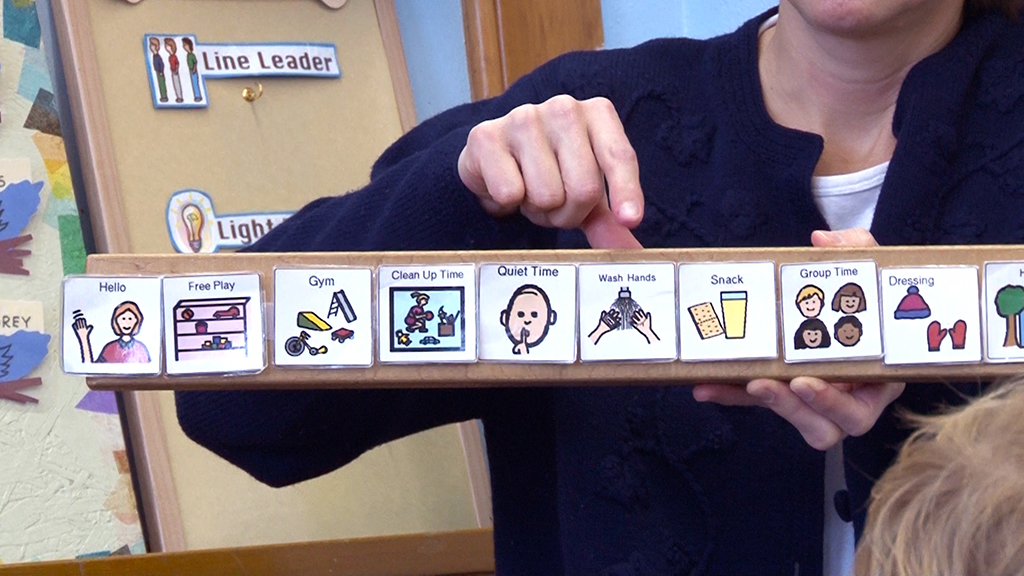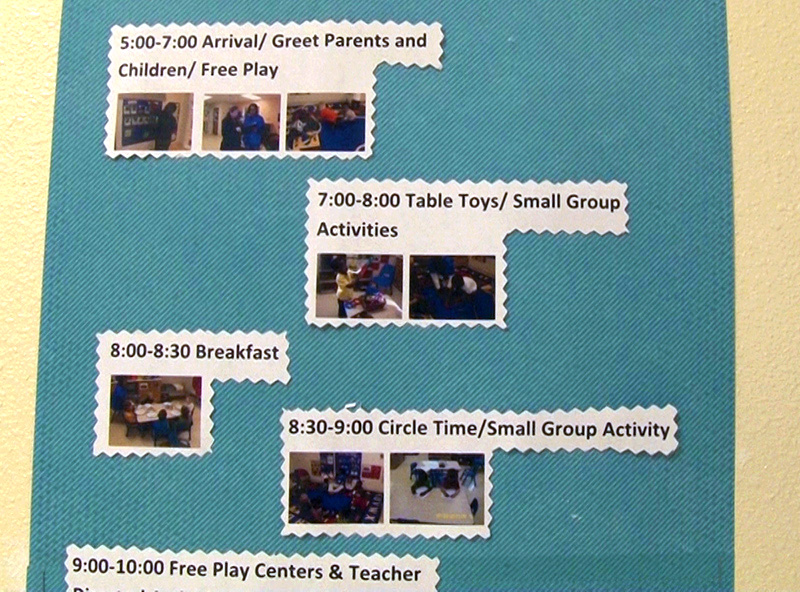


High-quality environments can guide children throughout their day and can help prevent challenging behaviors. This lesson describes how your preschool classroom environment can create meaningful opportunities for children to grow and learn about positive guidance.
ObjectivesThink about yourself and your life for a moment. What are some ways you help yourself navigate busy days within the environments in which you live, work, and spend your time? How do you ensure you stay on track, attend meetings or appointments, and complete your tasks? Perhaps you use an agenda, a planner, sticky notes, to-do lists, electronic devices, or other ways to help remind yourself of what you need to be doing? We all depend on different types of support to help us keep going, stay on track, achieve goals, and ultimately be successful.
Now think about how you feel when you are certain about what you are doing, what is going to happen next, and when you have organization and structure in your daily and weekly life? Do you feel happy? Content? Calm? At ease? What happens if you do not have all the supports that allow you to have structure and organization in your day? You may be able to function for a day or two, but in the long run, you are probably going to feel frustrated, confused, anxious, or even angry and upset at some point.
Just as you need supports to be able to function successfully and to navigate your day-to-day experiences, children need structure in their daily environments. Children thrive when placed in organized environments that provide structure and predictability while allowing for flexibility and respect for individual differences.
Your classroom environment should be a nurturing and supportive space that encourages positive interactions between children. It should be safe, stimulating, and developmentally appropriate. High-quality environments provide opportunities for children and adults to interact and play together while using a variety of materials. These environments make children feel welcome, validate children’s thoughts and feelings, and provide children with numerous opportunities for exploration. High-quality environments capitalize on relationship-building, appropriate expectations for behavior, predictable schedules and routines, and actions that address the needs of all learners. The remainder of this lesson will discuss each of these elements.
As a preschool teacher, it is your responsibility to create supportive environments that foster and promote relationship-building and a sense of community. Developing positive relationships with children, families, and your colleagues is the first and most essential strategy for preventing challenging behavior. All guidance occurs in the context of these relationships and when children and adults understand one another, value one another, and respect one another. Teachers that actively work on relationship-building are likely to have fewer instances of misbehavior because children understand that adults are there to help rather than to hinder.
Think about the last time you received feedback from a colleague or friend. It is often easier to hear feedback from someone you have a good relationship with. The positive experiences that have been shared between you make it easier to accept support or to be challenged by that person. Hearing feedback from a stranger or someone you do not feel as close with can often be hard to hear. Try relating this to your interactions with children. If a child in your classroom is frequently acting out in the presence of a particular adult, the interactions that precede this should be examined to determine where improvements could be made.
You can encourage positive social interactions by demonstrating mutual respect toward children. This includes modeling respectful forms of communication, respecting the decisions children make, and respecting overall differences in others. You encourage these positive interactions by modeling them yourself. Demonstrate respect for your colleagues through your words and actions.
A relationship is a sustained interaction with emotional connections over time. Relationships take time to develop and have important meanings among the individuals involved. Fostering relationships is an ongoing process that enables children to learn things about themselves, others, and their environments. Practices that promote nurturing and responsive relationships include supporting children’s play, responding to children’s conversation, providing positive feedback, encouraging appropriate behavior, building relationships with each child and family, and collaborating with classroom staff members and other professionals (Fox, Lentini, & Binder, 2013).
Positive expectations can set the tone for guidance in your classroom and program. These expectations must be age-appropriate for the children in your care. Preschool children can benefit from having a set of three to five positively and clearly stated expectations that guide all interactions in the classroom. You must understand these expectations yourself, teach them to the children, and talk about them throughout your day. You may also want to ask children in your classroom to brainstorm ideas when developing these expectations. Then, you should work with children to remind one another of these expectations. You will find some examples of expectations in the Safe Environments course.
Preschoolers need access to materials that encourage dramatic play, construction, writing, art, science exploration, music, and sensory materials. At this developmental stage, it is important to plan activities that incorporate fine- and gross-motor skills both indoors and outdoors. For example, if a preschooler is having difficulty sitting still during story time, constantly redirecting them to pay attention is likely to result in more unwanted behavior. Instead, encouraging the child to release energy in a gross motor area set up in the corner would be an example of developmentally appropriate guidance. Likewise, rather than forcing a reluctant child to participate in a game of kickball, it would be more appropriate to encourage them to explore the leaves and insects in the grass using a magnifying glass. Then, they could then report to others what can be found beneath the grass on which they are playing. The Learn section handout, Physical Space Design, provides suggestions for consideration when it comes to classroom physical design in preschool. Additionally, in the Explore section of this lesson you will have an opportunity to reflect on how your classroom’s physical space and design may be contributing to children’s behaviors. You can find more information on developmentally appropriate environments that support positive guidance in the Learning Environments course.
Managing time and the daily sequence of events is an important part of positive guidance. A predictable schedule can prevent behavioral outbursts and reduce anxiety in children, especially those who are resistant to change or surprises. Providing structure and predictability helps everyone know what is to be expected throughout the day. This is best achieved by posting a daily schedule.
A daily schedule should be displayed and followed while allowing for some flexibility. Higher-interest activities (e.g., such as free choice or outside time) should be scheduled after lower-interest activities (e.g., whole group time) to ensure the children are interested and motivated. Of course, the children’s physical needs should always come first. This includes meals, bathroom breaks, safety, and opportunities for rest throughout the day.


Transitions should be made as calmly and orderly as possible. There are a number of ways to add structure to transitions. For example, children could be called to line up based on the color of their shirts or hair. Or a song could be sung or played with the expectation that children are where they need to be by the end of the song. When a group transition is necessary (e.g., when preparing to get on the bus for a field trip), you should be prepared before the transition, so children do not need to wait. Make sure you have all materials ready, the bus is parked out front, etc., before you begin the transition. Consider leadership roles for children (can a child be responsible for distributing program T-shirts?) and ways to involve the children in the transition (children count themselves out loud as they line up).
High-quality environments send powerful messages to children about the ways they should conduct themselves and treat others. Think about what you have read in this lesson related to schedules and routines, relationship building, classroom design, and appropriate expectations. Neglecting to pay attention to these elements ahead of time can significantly affect children’s behaviors and actions in your classroom. There are many reasons why children engage in challenging behaviors in preschool. They might spend too much time doing one activity (e.g., sitting too long for circle time when this is not developmentally appropriate), not know the expectations for what they need to be doing (e.g., not knowing how to use certain materials at a particular center), wait too long for things to happen (e.g., going through too many transitions during the day that take too long), or simply not have specific directions or expectations about what they need to be doing during the day.
Consider some of the areas in your classroom and regular activities: busy-center work, large-group activities, lunch and snack time, potty time, free-play time indoors and outdoors, or other classroom and program happenings. Take a few seconds to consider what you are currently doing during these times to ensure children understand what is expected. Further, ensure they know what is and what is not acceptable.
Challenging behaviors often involve conflicts among children. Being able to resolve conflicts and solve problems are important social skills for young children because these skills enable them to make and keep friends, complete their daily routines without problems, and engage in meaningful learning experiences. Children who are able to solve problems and resolve conflicts with peers are more likely to engage in positive interactions with peers, make and keep friends, and have a more positive transition to kindergarten. Problem solving and conflict resolution involves self-regulation, communication, identifying and talking about emotions, and working together with other children. Teaching children to problem solve can help reduce impulsive behavior, help children talk about their emotions and prevent aggression and other challenging behaviors. In the Apply section of this lesson, you will find resources to help support children’s guidance.
Children in your classroom who have disabilities or who experience challenging life events or circumstances may also experience challenges with behaviors. These challenges may influence their ability to benefit from high-quality early education and to engage in positive social interactions with peers and adults. Even though challenging behaviors are typical for young children, some children show persistent challenging behaviors that may affect their overall school experience. It is important to provide children with the support they need so they can benefit as much as possible from their school experiences. For these children, you may need to adapt your curriculum, environment, and classroom experiences to enable them to be successful.
You will also have to work with children’s families to ensure consistency between school and home. Families may benefit from your classroom strategies that support children’s positive behaviors. Some children in your care may have conditions that affect their social and emotional development, including developmental delays, autism, neurological and perceptual disorders, or language and communication delays. Children with individualized education programs (IEPs) have a specific plan to help them meet their education goals. Very often, these children will need changes or adaptations to curriculum, classroom environment, and daily preschool routines.
It is critical that you get to know the children in your classroom to be able to support their successful participation in your program experiences. Make sure all children and families feel welcome and involved. The Kids Included Together (KIT) program can be a valuable resource for ideas. You can also consider Building Blocks and Kara’s Kit. These resources from the Council for Exceptional Children Division for Early Childhood provide practical, real-world ways to help children succeed in their environments.
Watch this video to learn about designing environments that support children’s guidance in preschool.
Watch this video to learn about setting up classroom rules.
The following are characteristics of high-quality environments that support children’s success in preschool. In your daily interactions with children in preschool, consider the following:
It can be useful to ask a trainer or coach to observe your classroom environments and give you feedback on how these environments function. You can use this information to reflect on the appropriateness of your classroom spaces. Complete the Observing Environments Activity. Share and discuss the findings with your trainer, coach, or administrator.
There are many tools available to help you think about and reflect on your use of positive guidance techniques and environmental arrangements. The National Center for Pyramid Model Innovations (NCPMI) provides practice implementation checklists that can help you become aware of strategies that prevent challenging behavior and promote social and emotional development. Download and print the attached Pyramid Model Practices Implementation Checklist for Preschool Classrooms. For additional resources from NCPMI, please visit the following website:
Expectation: A guideline for behavior, like a rule except typically broader and applying to all the settings a child might be in
Relationships: Sustained interactions with emotional connections with, important meaning between the individuals involved
Routine: An event that happens daily like snack, toileting, diapering, arrival, departure, or clean-up
Transition: The movement between one activity and the next, usually involving stopping one activity and starting a new one
Visual support: An object that is used to communicate information to children through pictures, drawings, or images; examples include picture schedules, rule charts, classroom signage
Berk, L. E. (2012). Child development (9th ed.). Pearson.
Division for Early Childhood (2010). Position statement: Identification of and intervention with challenging behavior. Young Exceptional Children, 13(5), 47-48. Doi: 10.1177/1096250610388151
Fields, M. V., Merritt, P. P., Fields, D. M., & Perry, N. (2014). Constructive guidance and discipline: Birth to age eight. Pearson Higher Ed.
Fox, L., Lentini, R., Binder, D. P. (2013). Promoting the social-emotional competence of all children: Implementing the pyramid model program-wide. Young Exceptional Children Monograph Series No. 15, 1-13.
Grisham-Brown, J., Hemmeter, M. L., & Pretti-Frontczak, K. (2005). Blended practices for teaching young children in inclusive settings. Paul H. Brookes Publishing Co.
Harms, T., Cryer, D., & Clifford, R. M. (2005). Early childhood environment rating scale (rev. ed.). Teachers College Press.
Horner, R., Lewis-Palmer, T., Sugai, G., & Todd, A. (2005). School-wide evaluation tool (SET). https://www.pbis.org/resource/school-wide-evaluation-tool-set
Inventory of practices for promoting children’s social emotional competence. (2010). Center on the Social and Emotional Foundations for Early Learning. http://csefel.vanderbilt.edu/resources/inftodd/mod4/4.8.pdf
Kinder, K., & Meeker, K. (2014). Front porch series: Moving right along: Planning transitions to prevent challenging behavior. Early Childhood Learning and Knowledge Center. https://earlychildhoodnewsupdate.com/2014/05/16/moving-right-along-planning-transitions-to-prevent-challenging-behavior/
McLean, M. E., Wolery, M., & Bailey, D. B. (2003). Assessing infants and preschoolers with special needs. Merrill Prentice Hall.
National Association for the Education of Young Children. (2009). Welcome children and families to your classroom. Teaching Young Children, 5(2), 6-7. https://www.naeyc.org/resources/pubs/tyc/apr2013/welcome-children-and-families
Trawick-Smith, J. W. (2014). Early childhood development: A multicultural perspective (6th ed.). Pearson Education Inc.